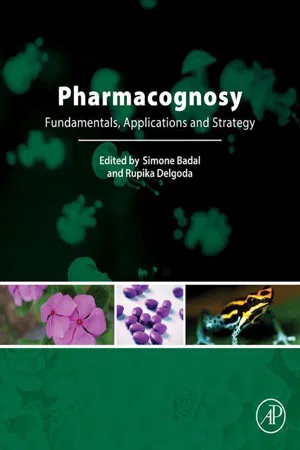1.2.1 General History
The word “Pharmacognosy” was first used in a work entitled “Analecta Pharmacognostical” by an Austrian physician Schmidt in 1811, and then by Anotheus Seydler in 1815. During these early days, the term “Pharmacognosy” was used to refer to a branch of medical science that was associated with drugs in their crude state. It was involved in the investigation of “medicinal substances from the plant, animal, and mineral kingdoms in their natural, crude or unprepared state or in the form of such primary derivatives as oil, waxes, gums, and resins” [9]. The descriptive and microscopic applications of Pharmacognosy were developed during the 19th and 20th centuries [10], and formed the regulatory basis for the use of plants in health systems based on pharmacopoeial definitions. However, in the 1960s and 1970s, there began a transition of Pharmacognosy from a descriptive botanical research discipline to a more integrated chemical and biologically focused one [10].
Many great scientists have contributed to the development of Pharmacognosy as a discipline, and as a speciality branch of academic pharmacy. These include Arthur E. Schwarting, Egil Ramstad, Varro E. Tyler, Jack L. Beal, and Norman R. Farnsworth, all from the United States of America. Others of note are James W. Fairbairn, Edward J. Shellard, and Norman Bissett from the United Kingdom. Also included from Europe and East Asia are René R. Paris, Egon Stahl, Ludwig Hörhammer, Hildebert Wagner, Otto Sticher, Shoji Shibata, and Tsunematsu Takemoto [10].
As late as the 1960s, Pharmacognosy, as a discipline of pharmacy education, was primarily associated with botany. At this stage, it was mostly concerned with the macro- and microscopic identification, description, and authentication of drugs. This area of Pharmacognosy is referred to as classical Pharmacognosy, and is still of fundamental importance in the field as a whole, especially for the purpose of preliminary standardization and quality control processes which are helpful in the development of official pharmacopoeial standards. Specific attention was paid to the microscopic identification of plant materials and to the determination of quantitative data such as foreign matter, ash values, extractive values, and moisture content. Subsequently, chromatographic fingerprints, especially TLC, were used for identification and standardization purposes. This classical Pharmacognosy, which focused initially on the pharmacognostic evaluation of plants, has been further extended to include other natural forms, such as various types of microbes and marine organisms.
Over time, a shift occurred from the classical Pharmacognosy to a more chemically and biologically focused discipline, one which involves the isolation and characterization of bioactive principles from natural sources, as well as the evaluation of structure–activity relationships of the isolates for the purpose of optimizing their development into medicinal agents for clinical use. DNA identification of natural products as a regulatory standard is also a current focus in Pharmacognosy.
Today, Pharmacognosy, as an academic department, is well-established in some schools of pharmacy all over the world, although the name might have been replaced by terms such as pharmaceutical biology, phytochemistry, and natural product research in certain countries. The area of research pharmacognosists is involved in, includes analytical chemistry, bioactivity assessment methods development, biocatalysis, biosynthesis, biotechnology, cell biology, chemotaxonomy, clinical studies, cultivation of medicinal plants, ethnobotany, genetics, marine chemistry, microbial biotransformations, molecular biology, synthetic modification of natural products, pharmacology, phytochemistry, phytotherapy, standardization of traditional medicines, taxonomy, tissue culture, and zoopharmacognosy. [10].
Despite the promise of natural product research over the years, this field experienced a decline in attention relative to other areas of research. Nonetheless, there is now a renewed interest in medicines, herbicides, and insecticides from natural sources, and consequently Pharmacognosy and natural product research have experienced elevated attention.
The use of plants in the management of ailments dates as far back as the origin of man itself. Several cultures of the world used herbs for healing rituals and certain carnivorous animals, e.g., Jaguar are also known to eat plants when ill. Thus, the use of plants for medicinal purposes started long before any form ...


